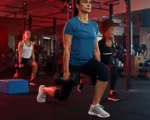Crafting a workout program tailored to your fitness goals can seem overwhelming, but it doesn’t need to be. A well-structured plan that incorporates a variety of exercise types can set you on the path to achieving your goals, whether that’s weight loss, muscle gain, or increasing endurance. Here, we’ll outline a comprehensive guide for building a workout program that delivers results.
Step 1: Define Your Fitness Goals
Before jumping into exercises, it’s important to clearly define your goals. Do you want to lose weight, build muscle, or improve endurance? Your goals will determine the type, intensity, and frequency of your workouts.
Examples of Fitness Goals:
- Weight Loss: Focus on calorie-burning exercises, like high-intensity interval training (HIIT) and cardio.
- Muscle Gain: Incorporate strength training exercises with progressive overload (gradually increasing weight or resistance).
- Endurance Training: Prioritize cardio with moderate intensity, such as long-distance running or cycling.
A clear objective will help you stay motivated and measure your progress.
Step 2: Include a Mix of Workouts
A balanced workout program should incorporate three primary types of exercises to target different aspects of fitness:
1. Cardio
Cardio exercises are essential for overall heart health, burning calories, and building stamina. These activities are particularly effective for weight loss and endurance improvement.
Examples of Cardio Workouts:
- Running or jogging
- Cycling
- Jump rope
- Swimming
- Rowing machine
💡 Pro Tip: For weight loss, aim for 30–45 minutes of moderate to high-intensity cardio, 3–4 times a week.
2. Strength Training
Strength training is perfect for building muscle, improving bone density, and boosting metabolism. This type of workout targets specific muscle groups and is key for reshaping your body.
Strength Training Exercises:
- Squats (for legs and glutes)
- Deadlifts (for the back and legs)
- Bench presses (for chest and arms)
- Pull-ups or lat pulldowns (for the back)
- Dumbbell bicep curls (targeting arms)
💡 Pro Tip: Train each major muscle group at least twice a week. Use compound exercises (e.g., squats, deadlifts) for maximum effectiveness.
3. Flexibility and Mobility
Often overlooked, flexibility and mobility exercises are critical for preventing injury, improving posture, and enhancing overall performance. These exercises ensure a good range of motion in your joints and keep your muscles supple.
Flexibility Workouts:
- Yoga
- Dynamic stretches (e.g., leg swings, arm circles)
- Static stretches (held positions post-workout, like hamstring stretches)
💡 Pro Tip: Dedicate at least 10 minutes to flexibility exercises after each workout or incorporate a yoga session once a week.
Step 3: Choose the Right Frequency and Intensity
Finding the right balance of how often and how hard you train is crucial. Overtraining can lead to injuries, while under-training may not yield results.
General Guidelines:
- Beginners: Combine 2–3 cardio and 2–3 strength workouts weekly. Take rest days seriously.
- Intermediate to Advanced: Aim for 4–5 days of mixed training while incorporating active recovery days.
- Intensity: Use the Rate of Perceived Exertion (RPE) scale or heart rate monitor to maintain the right level of difficulty.
For weight loss, prioritize HIIT and moderate weights. For muscle gain, focus on heavier resistance with fewer reps.
Step 4: Create a Weekly Schedule
Structuring your week helps build consistency. Here’s an example of a balanced schedule:
| Day | Activity |
|---|---|
| Monday | Cardio (e.g., running or cycling) |
| Tuesday | Strength training (upper body focus) |
| Wednesday | Flexibility exercises or yoga |
| Thursday | Cardio (e.g., HIIT or rowing) |
| Friday | Strength training (lower body focus) |
| Saturday | Cardio or endurance training (long run) |
| Sunday | Rest or active recovery (e.g., walking) |
Customize your routine based on your availability and specific goals.
Step 5: Pay Attention to Nutrition and Recovery
No workout program is complete without proper nutrition and recovery. You can’t out-train a poor diet or neglect giving your body time to heal.
Nutrition Tips:
- For weight loss, maintain a calorie deficit through a healthy diet.
- For muscle gain, prioritize protein intake and a calorie surplus.
- Stay hydrated before, during, and after exercise.
Recovery Tips:
- Get 7–9 hours of sleep every night.
- Incorporate rest days or active recovery.
- Use tools like foam rollers to alleviate muscle soreness.
💡 Bonus Tip: Track your progress with photos, measurements, or workout logs to stay motivated.
Step 6: Adapt Over Time
Your fitness needs will change as you progress. Gradually increase the intensity, duration, or complexity of your workouts to avoid hitting a plateau. This is where monitoring your performance pays off.
For example:
- Swap steady-state cardio for HIIT.
- Add more weight or sets during strength training.
- Try advanced yoga poses or new flexibility drills.
Adapting prevents boredom and continues to challenge your body.
Final Thoughts
Creating an effective workout program doesn’t need to be complicated. With a clear goal, a variety of workouts, and a commitment to consistency, you can build a program that fits into your lifestyle and delivers results. Whether you’re chasing weight loss, muscle growth, or greater endurance, the principles outlined above will help you succeed.
Ready to take the first step? Explore thousands of free workout routines and expert advice at Muscle and Strength to customize a program tailored to your needs.








